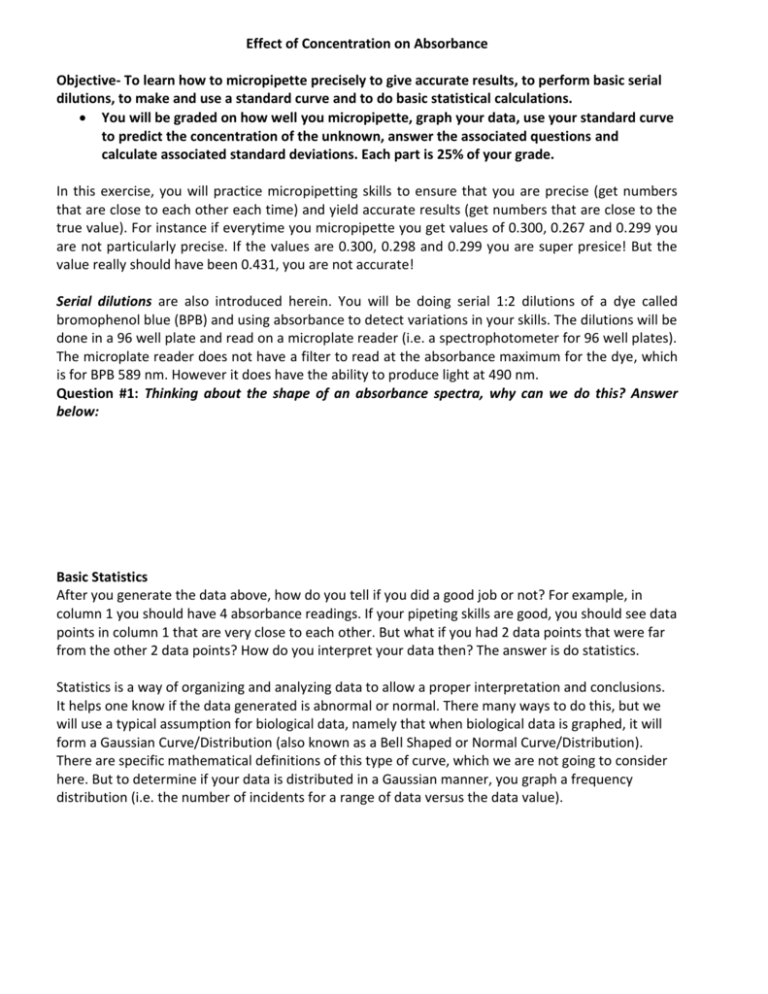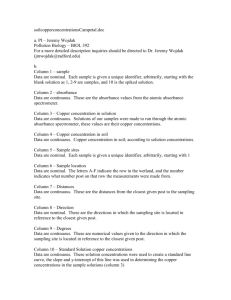Effect of Concentration on Absorbance
advertisement

Effect of Concentration on Absorbance Objective- To learn how to micropipette precisely to give accurate results, to perform basic serial dilutions, to make and use a standard curve and to do basic statistical calculations. You will be graded on how well you micropipette, graph your data, use your standard curve to predict the concentration of the unknown, answer the associated questions and calculate associated standard deviations. Each part is 25% of your grade. In this exercise, you will practice micropipetting skills to ensure that you are precise (get numbers that are close to each other each time) and yield accurate results (get numbers that are close to the true value). For instance if everytime you micropipette you get values of 0.300, 0.267 and 0.299 you are not particularly precise. If the values are 0.300, 0.298 and 0.299 you are super presice! But the value really should have been 0.431, you are not accurate! Serial dilutions are also introduced herein. You will be doing serial 1:2 dilutions of a dye called bromophenol blue (BPB) and using absorbance to detect variations in your skills. The dilutions will be done in a 96 well plate and read on a microplate reader (i.e. a spectrophotometer for 96 well plates). The microplate reader does not have a filter to read at the absorbance maximum for the dye, which is for BPB 589 nm. However it does have the ability to produce light at 490 nm. Question #1: Thinking about the shape of an absorbance spectra, why can we do this? Answer below: Basic Statistics After you generate the data above, how do you tell if you did a good job or not? For example, in column 1 you should have 4 absorbance readings. If your pipeting skills are good, you should see data points in column 1 that are very close to each other. But what if you had 2 data points that were far from the other 2 data points? How do you interpret your data then? The answer is do statistics. Statistics is a way of organizing and analyzing data to allow a proper interpretation and conclusions. It helps one know if the data generated is abnormal or normal. There many ways to do this, but we will use a typical assumption for biological data, namely that when biological data is graphed, it will form a Gaussian Curve/Distribution (also known as a Bell Shaped or Normal Curve/Distribution). There are specific mathematical definitions of this type of curve, which we are not going to consider here. But to determine if your data is distributed in a Gaussian manner, you graph a frequency distribution (i.e. the number of incidents for a range of data versus the data value). Figure 1- Frequency Distribution of the number of seconds it took took for the average person to get their cell phone out of their backpack. For about 800 people it took less than 1 second. For about 1300 people it took between 1-2 seconds, etc. (http://www.bing.com/images/search?q=Types+Of+Frequency+Distribution+Graphs&view=detail&id=64E7CB921E7CB79D4DBCC124431B37DF51AE61 2D) In Figure 1, a frequency distribution is shown for the number of seconds needed to remove a cell phone from a backpack. The experimental data was graphed with the number of data points (Counts of people) on the y-axis and time in seconds on the x-axis. If after doing this, your data forms a bell shaped curve, you can use specific formulas to calculate the average (mean or ) and standard deviation (s or ). The standard deviation tells you the spread of the data in your data set around a mean. Mean Calculation- For each type of data point, average all values for a subset of data together. Standard Deviation- Where: Σ = Sum of X = Individual score (data point) M = Mean of all scores N = Sample size (Number of scores) (http://www.easycalculation.com/statistics/learn-standard-deviation.php) So for each data point one subtracts the mean from a data point and squares it. These are all added together and divided by the number of data points overall minus 1. Then take the square root of this number. Your instructor will provide an example of mean and standard deviation. Use your data from your micropipetting activity to calculate the mean and standard deviation of your data and write the values in the boxes as indicated. Assessing your micropipeting: Excellent job standard deviations from less than +/- 0.005 Good job standard deviation +/- 0.006 to +/- 0.05 Poor job standard deviations +/0.060 or more Method 1. Obtain a 96 well plate and label the columns 1-6 from left to right 1.25 M, 0.625 M, 0.312 M, 0.15 M, 0.075 M and 0.037 M. Label the Rows A-D. 2. Use a p200 micropipettor to transfer 200µL of distilled water into each of the labeled wells. 3. Add 200µL of stock 2.5 µM BPB to column 1 wells A-D. This column now represents a 1:2 dilution. 4. Pipette 200µL from column 1 into column 2. This is a 1:4 dilution (1:2 of a 1:2 = 1:4 ). Mix by pipetting up and down 3 times empty and discard tip into the waste beaker provided. 5. Repeat for the remaining labeled columns. 6. Discard the extra 200µL in the wells of the last column so that all wells have 200 l. 7. Pipet 200µL of the unknown in two separate wells. 8. Pipet 100µL of the unknown in two separate wells. 8. Set the plate reader to the Amax wavelength for BPB (489 nm). 9. Read the absorbance of each well in the plate and print-out your results. 10. Calculate the mean and standard deviation for each column. You will have 4 replicates of each concentration of BPB. This will show you the precision of your pipetting. Ideally you should have very low standard deviations for each concentration. Write your answers in the chart on the next page. 11. Graph your results on the graph paper at the end of the exercise, with meaningful titles for the axes and graph overall. Your instructor will give you an example of a good graph. There are two sheets of graph paper at the end of the exercise with which to work. It is expected that you will: have a meaningful title on the graph have a meaningful title on the axes label the x-axis with a “x” and the y-axis with a “y” Use the data points to make a straight line. That means if your data does not follow a straight line, you must draw the “best fit line” putting an equal number of points on the top and bottom of the line With the absorbance of the unknowns, indicate the predicted concentration of your unknown. Data Table: Column 1 Column 2 Column 3 1.25M 0.625 M 0.312 M Column 4 0.15 M Column 5 Column 6 Column 7 0.075 M 0.037 M Unknown A B C D Mean +/Stand. Dev Question 2: Did you get two different values for the unknown tested at 100 l vs 200 l? Considering your understanding of absorbance and the Beer Lambert Law, how can you explain your results? Question #3: If you diluted 115 l of the unknown with 115 l of water before taking the absorbance in the plate reader, what would happen to the absorbance value? 100 l 200 l Question #4: If you had 10 l of DNA what would be the easiest way to determine how much DNA you had in your sample?










